
Guests
- Dr. Michelle Tomfamily physician treating COVID-19 patients at Winslow Indian Health Care Center and Little Colorado Medical Center in northern Arizona near the Navajo reservation. She is a member of the Navajo Nation.
- Dr. Sriram Shamasunderassociate professor of medicine at University of California, San Francisco and co-founder of the HEAL Initiative.
We get an update from two doctors treating patients with the Navajo Nation, the largest Indigenous reservation in the country, which has been hard hit by the coronavirus pandemic. Dr. Michelle Tom is a member of the Navajo Nation and a family physician treating COVID-19 patients at the Winslow Indian Health Care Center and Little Colorado Medical Center in northern Arizona near the Navajo reservation. In Gallup, New Mexico, Dr. Sriram Shamasunder is leading a medical volunteer group of 21 nurses and doctors from the University of California, San Francisco as part of the HEAL Initiative. He says the coronavirus hit harder on the Navajo Nation due to a “trajectory of an underfunded health system,” and notes the Indian Health Service is funded at one-third the rate per capita as Medicare. “The level of inequity that you’re seeing … it’s part of this pattern.”
Transcript
AMY GOODMAN: This is Democracy Now!, democracynow.org, The Quarantine Report. I’m Amy Goodman in New York, the epicenter of the pandemic. Juan González is in New Jersey. It’s number two for coronavirus infections. And now we’re going to number three, per capita, Navajo Nation, as we continue to look at how the Navajo Nation has been so hard hit by the coronavirus pandemic, highest number of coronavirus infections per capita in the United States following New York and New Jersey. The rural community has reported having nearly 2,300 known cases of COVID-19, 73 deaths as of Sunday. The Navajo Nation is the largest Indigenous reservation in the United States with a population of some 350,000, a territory that spreads over 27,000 square miles.
As we turn now to two doctors who know this land well, on the ground treating patients. Joining us from Gallup, New Mexico, Dr. Sriram Shamasunder is a leading medical volunteer — he’s leading a medical volunteer group of 21 nurses and doctors from University of California, San Francisco, where he’s an associate professor of medicine, to the Native American reservation near Gallup. He’s the co-founder of the HEAL Initiative, which has worked across nine countries, including Navajo Nation, since 2015, promoting health equity. And joining us from Winslow, Arizona, Dr. Michelle Tom, member of the Navajo Nation, family physician, treating COVID-19 patients at the Winslow Indian Health Care Center and Little Colorado Medical Center in northern Arizona near the Navajo reservation. She was a basketball star in college at Arizona State University.
We welcome you both, Doctors, to Democracy Now! Dr. Tom, let’s begin with you. You work in the clinic where you were born. As you listen to Valentina’s story, a 28-year-old Navajo woman who suddenly died after being diagnosed with COVID-19, your response? Can you put it in the context of what’s happening right now in the Navajo Nation?
DR. MICHELLE TOM: It just kind of is a reflection of what we’re going through as a people, and it correlates with what this virus can do to our young and someone who was very motivated, loved our culture, spread our culture, our rich and strong, and our language. And that’s what we’re trying to fight for. You know, there’s not many who really promote really great things, who is a young person, and she was one of them. And she was going to lead our next generation. And so, it was a hard loss of our community.
JUAN GONZÁLEZ: And, Dr. Tom, why do you think there has been such a devastation in terms of COVID-19 throughout the Native population, especially in Navajo Country?
DR. MICHELLE TOM: I think the spread — we’re a very matriarchal society, and we have a connection to the land and to our community. And so, we really concentrate on the community. And when someone is sick, we tend to be there for one another. And we live in multigenerational homes. So, the contact of that and the spread is obviously more than we wanted, but that was just part of our culture, is to help one another and to visit one another and encourage one another. And being with a very strong family and all these strong ties, that was probably — you know, it’s multifactorial, but that was one of the reasons.
JUAN GONZÁLEZ: And what about the external conditions confronted day to day? For instance, as much as 40% of people in the Navajo reservation do not have running water, how that affects their ability to combat this disease?
DR. MICHELLE TOM: Oh, absolutely. And that’s from a long state of histories with treaties and our relationship with the government. We’ve had — set aside for certain things like that, and our infrastructure for water has never been at the capacity where we can provide water for everyone on the reservation. So, you’re telling people to wash your hands for 20 seconds, and yet people are trying just to get water just to drink and just to cook with. And we know that water is part of a healthy body. You know, so, when you’re trying to have people wash things all the time, we are struggling with just clean water in general.
AMY GOODMAN: I want to bring Dr. Sriram Shamasunder into the conversation. You’re leading this group of volunteer doctors and nurses from San Francisco to Navajo Nation. You’re in Gallup, that is put under lockdown right now by the governor because of this massive outbreak. You’ve described treating four generations of one family. Talk about your work that you’ve been doing there for years.
DR. SRIRAM SHAMASUNDER: Yes. So, I helped co-found the HEAL Initiative, which is a global health immersive fellowship that trains and transforms frontline health professionals to make serving the underserved a lifelong choice. And so, over the last five years, we’ve had 150 frontline health professionals come through our program. And half of them are U.S. doctors or nurses, and the other half are either Navajo or from countries such as Haiti or Mexico or Malawi or India. And so it’s this really diverse community of frontline workers that are trying to get better at serving underserved populations.
And we worked in Navajo Nation for the last five years, since 2015, and had partnerships. And I think it’s important to know that before COVID-19, Indian Health Service, Navajo population, what we’re seeing right now is this trajectory of an underfunded health system, where IHS is funded one-third the rate per capita as the VA or Medicare. And the level of inequity that you’re seeing and the COVID cases that you’re seeing in Gallup, as well as Chinle, it’s part of this pattern. You know, in Michigan and Chicago, we know that in Michigan, 14% of the population are Black folks, and yet 40% of the deaths are Black people. And in Navajo Nation and in New Mexico, 11% of the population is Native American, but you see almost a third of the cases, of COVID cases, being Native American.
And I think in — I’ve been practicing both in Gallup, New Mexico, with our team of volunteers, as well as Chinle, Arizona. In Gallup, I think what’s amazing is that I am running a sprint, but my colleagues, like Dr. Tom, have really been running this marathon for a long period of time. And so, in Gallup, they’ve done an amazing job. I think you’ve have seen this incredible local leadership, where they’ve been able to put 125 unsheltered people, community members, into motel rooms and have a collaboration to take care of them, as well as stop community spread.
And in Chinle, Arizona, this last weekend, I was taking care of patients. And like you mentioned, Amy, there’s been four generations — a great-grandmother, a grandmother, a mother and daughter — that were all hospitalized. And I think that this is what the Navajo — my Navajo colleagues have been dealing with for the last six weeks. And the surge is upon us, where, taking care of a grandmother this last weekend, we’re always deciding whether these facilities can manage.
And it’s such a humbling disease, because a lot of the facilities that we’re in, once you intubate the patient, you have to transfer them to Phoenix or Albuquerque. And so, all the providers are trying to learn what is the trajectory, because every time you intubate a patient, it’s just one more level beyond what we deal with in San Francisco, because the Navajo people, where the land is so sacred, they are going to wake up isolated in another city, such as Phoenix or Albuquerque. And I think that that is humbling. So, the providers, the Navajo providers, are trying to see how much can they take care of their patients in their facilities, and when is it not safe anymore and they’re going to have to transfer patients out.
JUAN GONZÁLEZ: Dr. Shamasunder, I wanted to ask you about the extraordinary mobilization of the tribal authorities to combat COVID-19, and also how the government of New Mexico, the state government, has responded. Obviously, there was a lot of reports about the state invoking the Riot Control Act and sealing off Gallup. Could you talk about both, the state response and the tribal government response, especially in view of what we’ve been seeing of the relative inaction at the federal level on this disease?
DR. SRIRAM SHAMASUNDER: Yeah. I think that the incredible resourcefulness and resilience of the Navajo people is totally apparent when we come here. We actually met with President Nez, the Navajo president, when we arrived. And he’s really been on the forefront of having people shelter in place. And really, you know, like Dr. Tom was saying, when you’re trying to shelter in place and you live with eight or 10 people and this expansive definition of family where the community is so connected, you’re going to have community spread. And so, the outbreak, I think, in Navajo Nation is not a lack of leadership. I think President Nez has been incredible at having these weekend lockdowns, which is extremely difficult for the Navajo people, and is really leading with wearing masks in public, and so doing all the right things, I think, from the national sovereign level. And he’s been very vocal to say that the federal response has been extremely slow.
And that’s what I’ve seen in Chinle, Arizona. We have HEAL fellows that are behavioral health coaches, that are not — are usually not taking care of COVID patients at this time, so they’ve taken over the cafeteria and are making PPE and sewing PPE, and so the whole cafeteria has folks sewing PPE. So, I think you see, from the top of the Navajo leadership to the citizens and health professionals, really leading an incredible response. And the federal government has just been incredibly slow.
And then, obviously, Gallup is a border town, which is not under jurisdiction of the Navajo government, but it is an area where a lot of Navajo people come to get groceries, come into town, and there’s a lot of activity. And it’s the second-highest caseload of new cases in the country in the last two weeks. And, you know, I’m here. I’m going to go on shift later today. And the Gallup providers have just said — earlier, last week, they said, you know, “I don’t think we need you.” And this week, they’re saying, “We’re getting exhausted. The surge is just coming and coming, and there’s more and more patients. And we need you to help out and do some shifts.” And I think the New Mexican government has been strong and really almost following the lead that the Navajo president has put in place.
AMY GOODMAN: And finally, Dr. Michelle Tom, we have 30 seconds. What you feel the rest of the country should understand, especially with compromised healthcare, in general, in the area, due to poverty, due to uranium mining and how that compromises the health of so many people?
DR. MICHELLE TOM: Yes, it’s just access, just funding. And it’s kind of made our work harder. But like Dr. Sri said, we’re coming together as community. I’m proud of our nation. I’m proud of the facilities I work for. And yeah, just getting the public health notice out there, of just wash your hands, social distancing, maybe hand sanitizer, and really just listening to our leaders right now, and healthcare professionals. So, you know —
AMY GOODMAN: We want to thank you so much, Dr. Michelle Tom —
DR. MICHELLE TOM: Thank you.
AMY GOODMAN: — speaking to us from Winslow, Arizona, Navajo Nation family physician, one of the few Navajo doctors on the reservation. And Dr. Sriram Shamasunder, associate professor of medicine at University of California, San Francisco, has led a group of doctors and nurses to Navajo Nation, has been doing that since 2015, and in Gallup, New Mexico, right now, which is under lockdown.
When we come back, the pandemic in prisons. We go to one prison in Ohio where 80% of the prisoners have tested positive, half the staff. We’ll go to Marion. And we’ll talk about prison abolition. Stay with us.
[break]
AMY GOODMAN: That’s the audio premiere of Steve Earle’s new song, “Union, God, and Country,” from his latest album, Ghosts of West Virginia, that will be released May 22nd and centers on the Upper Big Branch coal mine explosion that killed 29 men in that state in 2010, making it one of the worst mining disasters in American history. Steve Earle says, quote, “West Virginia was the most unionized place in America until very recently. Upper Big Branch was the first non-union mine on that mountain — and it blew up and killed 29 men. This is a song about better days,” he said.

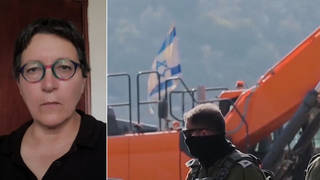
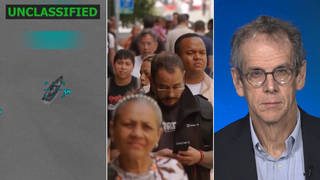
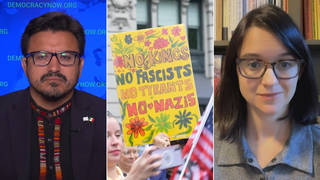
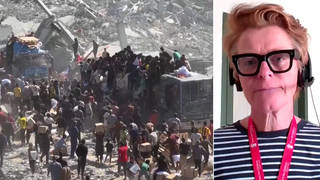





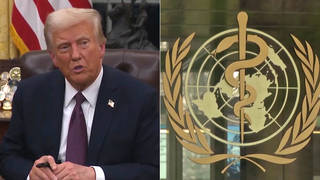
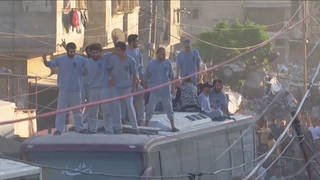
Media Options